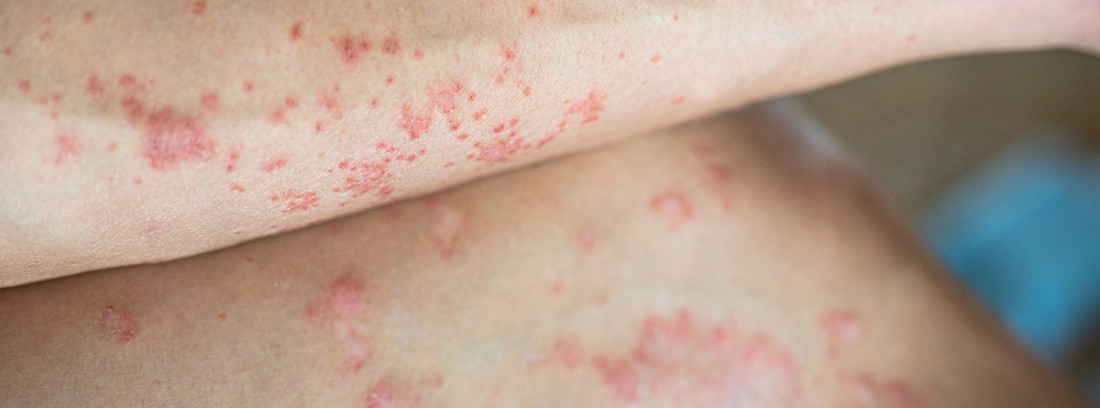Hidradenitis suppurativa

Hidradenitis suppurativa is a chronic inflammatory disease of the skin. This condition causes them to form painful and swollen lumpss in the body. The bumps often appear in places where the skin rubs and can cause so much pain that movement is difficult. They can smell bad or drain pus or blood and tend to last for weeks or months. This condition involves a suppurative disorder that mainly involves the sweat glands.
What are the symptoms?
The main symptoms are painful and swollen lumps. These lumps can drain pus or blood.
The bumps usually form in places where the skin rubs (intertriginous sites). The main sites of involvement of hidradenitis suppurativa are:
- Armpits
- Above or below the breasts (inframammary).
- Groin area.
- Inner thighs.
- Buttocks.
- Around or near the anus (perianal).
Skin problems caused by hidradenitis suppurativa last a long time and get worse over time. Often the skin becomes hard and around the painful bumps. Many lumps can form in a single area and sometimes tunnel under the skin.
The clinical manifestations vary, from swollen nodules and abscesses recurring until skin tunnels that drain (sinus tracts) and severe scarring bands. The associated pain, foul odor, drainage, and disfigurement that accompany hidradenitis suppurativa contribute to a profound psychosocial impact of the disease in many patients. People who have hydradenitis often have a hard time coping with their problem. It can make them feel embarrassed and worried. Sometimes the condition can even cause problems in relationships or in the workplace.
The diagnosis
The early lesions of hidradenitis suppurativa can mimic other disorders; The misdiagnosis of hidradenitis suppurativa as recurrent furunculosis or "boils" is common. It is important to quickly recognize the correct diagnosis. An early and accurate diagnosis facilitates the initiation of a treatment plan aimed at minimizing the risk of progression to a disabling terminal stage.
There is a clinical staging system, called Hurley's, that is often used to divide patients with hidradenitis into three groups of disease severity:
- Stage I: abscess formation (single or multiple) without sinus tracts and scarring / scarring.
- Stage II: Recurrent with sinus tracts and scarring, single or multiple widely spaced lesions.
- Stage III: Diffuse or nearly diffuse involvement, or multiple interconnected sinus tracts and abscesses throughout the area.
Most patients with HS have stage I disease.
When is it necessary to go to the doctor?
If you have symptoms of hidradenitis suppurativa you should see a doctor. They can examine your skin and find out if hidradenitis suppurativa is the cause of your symptoms. It's also important to see your doctor regularly, as people with hidradenitis suppurativa are also more likely to have other health problems, such as diabetes and heart disease.
CALCULATE YOUR PRICE
Treatment
Treatment may include:
- antibiotic liquids or gels that are applied to the affected skin.
- antibiotic pills, which you may need to take for a few months or more.
- Medication injections steroids in affected areas to reduce inflammation.
- Hormonal pills for some women with.
- A drug called adalimumab (brand name: Humira).
- Minor surgery.
Recommendations and conclusions
- The clinical manifestations of hidradenitis suppurativa appear to be the result of follicular occlusion and secondary rupture of the sebofollicular junction, resulting in an inflammatory cascade. Hidradenitis suppurativa it is not contagious nor is it due to poor hygiene.
- Hidradenitis suppurativa occurs mainly on intertriginous skin. The armpit is the most common site; the groin area, inner thighs, perineal and perianal areas, mammary and inframammary skin, and buttocks are additional common sites of involvement. Non-intertriginous skin involvement can also occur.
- The diagnosis of hidradenitis suppurativa is based on the recognition of characteristic clinical manifestations, including typical lesions at intertriginous sites that occur chronically and recurrently. Usually, a skin biopsy is not necessary for diagnosis.
- Early-stage diagnosis is often overlooked. The physician must have a high index of suspicion of the disease in individuals misdiagnosed with recurrent boils or "boils" in intertriginous areas (armpits, nostrils, skin folds of the breasts and between the fingers ...) after puberty.
- People who smoke are more likely to get hidradenitis suppurativa.
- Hidradenitis suppurativa is more common and severe in Overweight people.
- Hidradenitis suppurativa refers to a painful, chronic and suppurative process that involves the skin and subcutaneous tissue.
- An early and accurate diagnosis facilitates the initiation of a treatment plan aimed at minimizing the risk of progression to a disabling terminal stage.
- People who smoke are more likely to have hidradenitis suppurativa, and it is more common and severe in people who are overweight.
Dra. Alexandra Company Barceló
Teladoc Health Family and Community Medicine Physician
(Updated at Apr 14 / 2024)